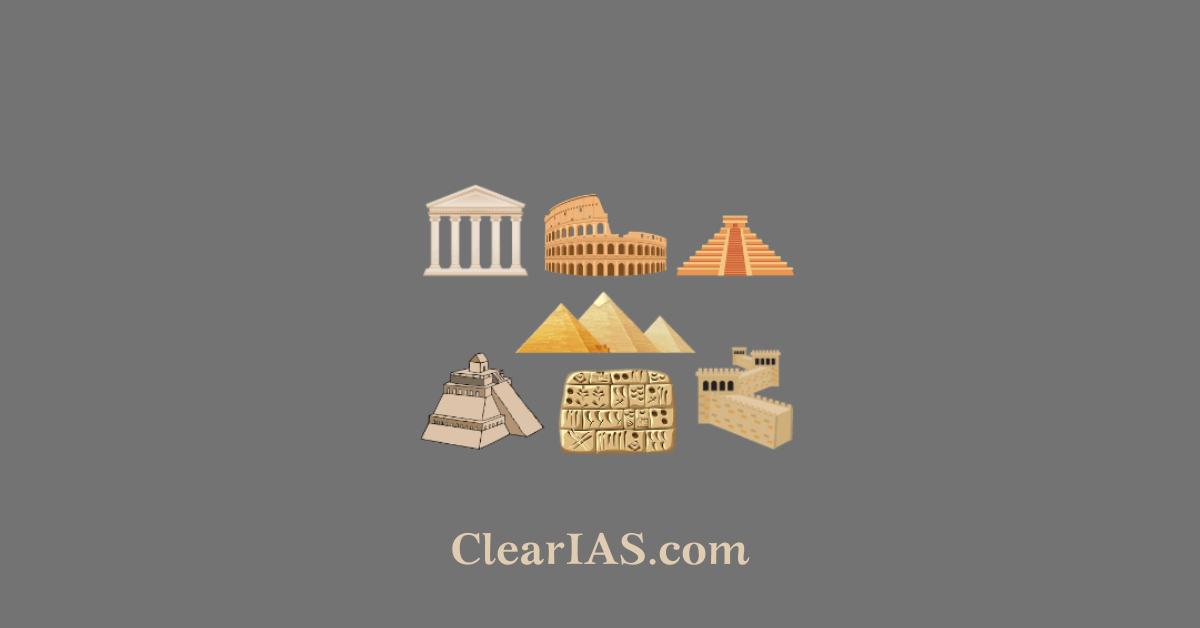
Ancient civilizations laid the foundational blocks for modern society, influencing everything from political systems and legal codes to art, architecture, and technology. Read here to learn more.
The history of human civilization is a fascinating tapestry of cultures, innovations, and stories that have shaped the world.
While modern civilizations extend to every continent except Antarctica, most scholars place the earliest cradles of civilization where civilizations first emerged.
They are in modern-day Iraq, Egypt, India, China, Peru, and Mexico, beginning between approximately 4000 and 3000 BCE.
Ancient Civilizations of the world
Civilization describes a complex way of life characterized by urban areas, shared methods of communication, administrative infrastructure, and division of labor.
- The earliest civilizations developed between 4000 and 3000 BCE. when the rise of agriculture and trade allowed people to have surplus food and economic stability.
- Many people no longer had to practice farming, allowing a diverse array of professions and interests to flourish in a relatively confined area.
- Civilizations first appeared in Mesopotamia (what is now Iraq) and later in Egypt.
- Civilizations thrived in the Indus Valley by about 2500 BCE., in China by about 1500 BCE., and in Central America (what is now Mexico) by about 1200 BCE.
- Civilizations ultimately developed on every continent except Antarctica.
All civilizations have certain characteristics. These include:
- large population centers;
- monumental architecture and unique art styles;
- shared communication strategies;
- systems for administering territories; a complex division of labor; and
- the division of people into social and economic classes.
- The development of urban settlements, and cities, is the primary characteristic of a civilization.
- The other attributes that define civilization are built around urbanization.
Civilizations expand through trade, conflict, and exploration.
- Usually, all three elements must be present for a civilization to grow and remain stable for a long period.
- The physical and human geography of Southeast Asia allowed these attributes to develop in the Khmer civilization.
- The Khmer flourished in parts of what are now Cambodia, Thailand, Laos, Vietnam, and Myanmar between 800 and 1400.
Many civilizations have flourished and then failed or fell apart.
- There are many reasons for this, but many historians point to three patterns in the fall of civilizations: internal change, external pressure, and environmental collapse.
- The fall of civilizations is never the result of a single event or pattern. Sometimes, civilizations seem to “disappear” entirely.
The southern part of the modern country of Iraq is called the “Cradle of Civilization.” The world’s first cities, writing systems, and large-scale government developed there.
Mesopotamia
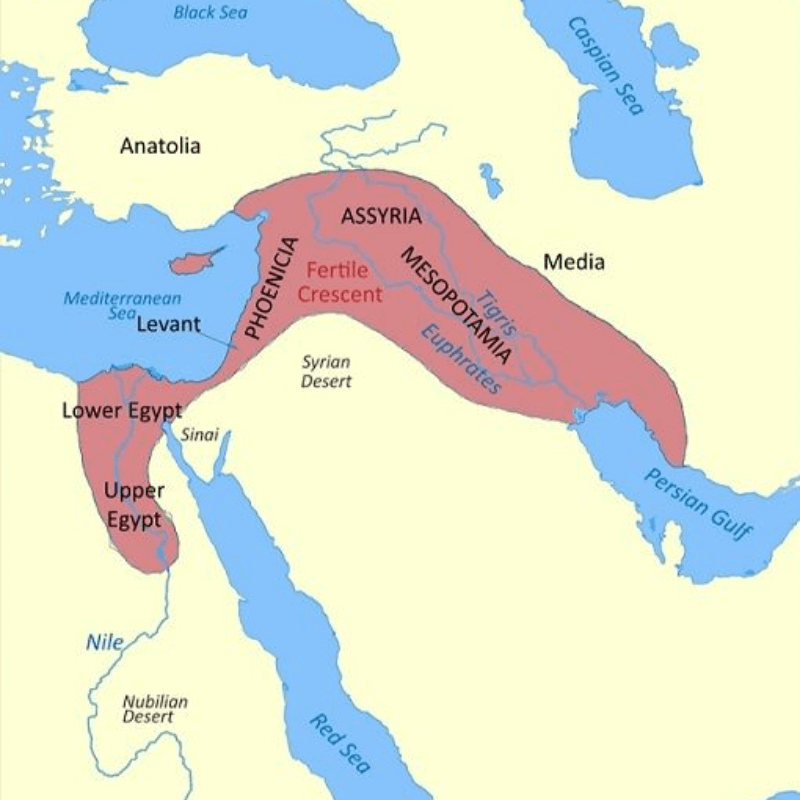
Mesopotamia was situated between the Tigris and Euphrates rivers, in the modern-day Middle East, primarily Iraq.
- Period: Around 3500 BCE to 500 BCE.
Known as the “Cradle of Civilization,” Mesopotamia is credited with many firsts, including the invention of the wheel, the development of cuneiform writing, and the establishment of city-states like Uruk and Babylon.
Below are some of the key civilizations that thrived in Mesopotamia:
Sumerians
- Circa 4500 BCE – 1900 BCE
- The Sumerians are credited with the invention of the wheel, the development of cuneiform writing, and the creation of city-states such as Uruk, Ur, and Eridu.
- They made significant advances in mathematics, astronomy, and agriculture.
Akkadians
- Circa 2334 BCE – 2154 BCE
- Under the leadership of Sargon of Akkad, the Akkadians established one of the world’s first empires, uniting the Sumerian city-states.
- They contributed to the spread of the cuneiform writing system and developed a more centralized government structure.
Babylonians
- Circa 1894 BCE – 539 BCE (with periods of independence and subjugation)
- The Babylonian Empire is best known for the Code of Hammurabi, one of the earliest and most comprehensive written legal codes.
- Babylonians made significant contributions to mathematics, including the development of a sexagesimal (base-60) number system, which influences how we measure time today.
Assyrians
- Circa 2025 BCE – 609 BCE (fluctuating periods of dominance)
- Known for their military prowess and the establishment of one of the most powerful empires of the ancient world, the Assyrians were also innovators in administration and technology.
- They built the renowned library of Ashurbanipal in Nineveh, which housed thousands of clay tablets.
Hittites
- Circa 1600 BCE – 1178 BCE
- Although primarily based in Anatolia (modern-day Turkey), the Hittites controlled parts of Mesopotamia at the height of their power.
- They are known for their advancements in iron technology, which gave them a military edge, and for their legal and political systems.
Chaldeans (Neo-Babylonian Empire)
- 626 BCE – 539 BCE
- The Chaldeans are best known for the Babylonian king Nebuchadnezzar II, who is credited with constructing the Hanging Gardens of Babylon and rebuilding the city of Babylon into a magnificent capital.
- They made significant advancements in astronomy.
Persians (Achaemenid Empire)
- 550 BCE – 330 BCE
- After conquering Babylon, the Persians, under Cyrus the Great, established an empire that extended beyond Mesopotamia.
- They are known for their system of roads, the Royal Road, their administrative system, and the respect shown to the cultures and religions of the peoples they conquered.
Ancient Egypt

The Egyptian civilization was centered around the Nile River in northeastern Africa.
- Period: Circa 3100 BCE to 332 BCE.
The Pharaohs of Egypt and their complex religious beliefs have left a lasting legacy on the world.
- They were renowned for their monumental architecture, such as the Pyramids and the Sphinx, and their advances in writing, agriculture, and governance.
- The ancient Egyptians also left a legacy of monumental writing and mathematics systems.
- The cubit, a measure of length roughly the span of a forearm, was key to designing the pyramids and other structures.
- They developed the 24-hour day and 365-day calendar during this time. They established the hieroglyphic pictorial writing system, followed by the hieroglyphic system that used ink on papyrus paper.
- The civilization came to an end in 332 B.C. when it was conquered by Alexander the Great.
To know in depth about ancient Egypt click here.
Indus Valley Civilization
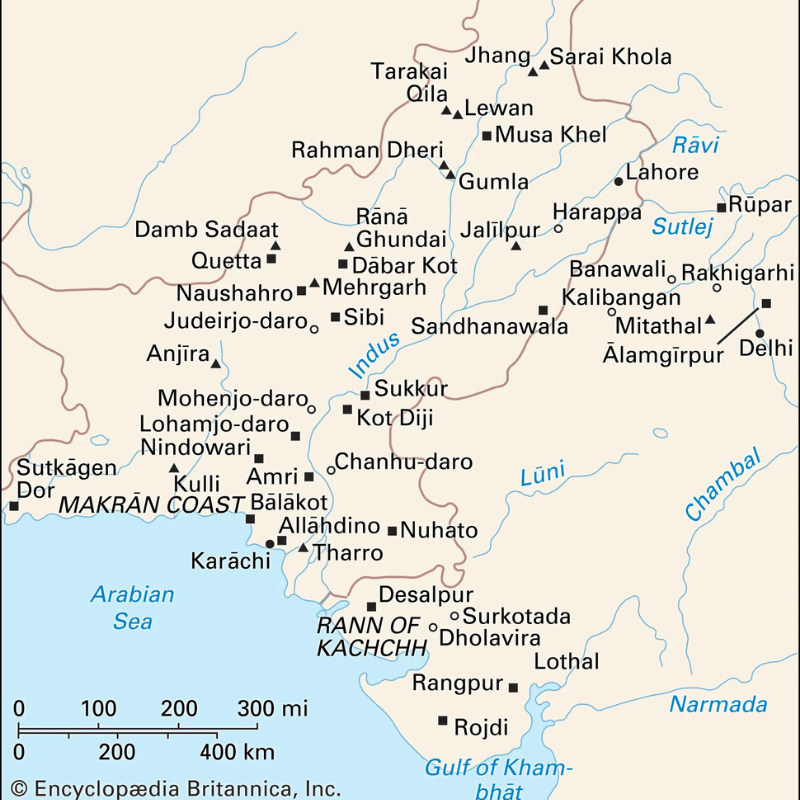
It was spread across modern-day Pakistan and northwest India.
- Period: Around 3300 BCE to 1300 BCE.
- Known for its advanced urban planning, including well-laid-out cities like Harappa and Mohenjo-Daro, with sophisticated drainage systems and standardized weights and measures.
Read: Indus Valley Civilization
Ancient China
The ancient Chinese civilization was centered on the Yellow River and later the Yangtze River in East Asia.
- Period: From circa 2100 BCE, though Chinese civilization continues through various dynasties into the modern era.
They gave the world paper, gunpowder, compass, and printing technology.
Its philosophical contributions, including Confucianism and Taoism, and the construction of the Great Wall are also notable.
- The first farming settlements appeared there around 5000 BCE., and from these modest foundations grew a centralized government.
- Generally divided into four dynasties-Xia, Shang, Zhou, and Qin-ancient China was ruled by a succession of emperors.
- Starting with the Xia (2070-1600 BCE.), several successive dynasties dominated Chinese civilization.
- In the Shang Dynasty (1600-1046 BCE.), Chinese scribes wrote with characters that resemble those used today, and by around 400 BCE., the ideas of famous figures such as Confucius began blossoming into full-fledged belief systems stressing virtue and filial piety.
- Beyond these philosophical achievements, Chinese artisans created the first silk and the first forms of paper.
- They also fashioned the first block printing processes and maritime compasses.
- The traditions of acupuncture and herbal medicine have become one of China’s longest-lived contributions.
Read: Chinese history
Ancient Greece

The Greeks were located in southeastern Europe, comprising city-states like Athens, Sparta, and Corinth.
- Period: Circa 800 BCE to 146 BCE.
Ancient Greece is known as the birthplace of Western philosophy, democracy, the Olympic Games, significant scientific and mathematical principles, and profound literary and artistic achievements.
- In approximately 7000 BCE., agricultural settlements appeared across the Aegean Sea and grew into societies including those of the Minoans and Mycenaeans.
- They developed the first forms of their language and worshiped several gods and goddesses who would ultimately populate the Greek pantheon, including Zeus, Poseidon, and Athena.
- They also inspired ancient Greece’s most important myths, including their account of the legendary Mycenaean soldiers Achilles and Odysseus and their activities in the Trojan War.
- By 1100 BCE., the Minoan and Mycenaean cultures collapsed, and around the 8th century BCE., a smattering of independent city-states, including Athens, Sparta, and Thebes, began to dominate the Greek world.
- Though these city-states possessed distinct cultures, they shared a language, religion, and interest in innovation.
- Greek thinkers paved the way for modern medicine, mathematics, and science, and became the first proponents of ideas such as atomism and heliocentrism.
- It was also ancient Greek figures – including Socrates, Plato, and Aristotle – who fostered Western philosophy.
The Roman Empire
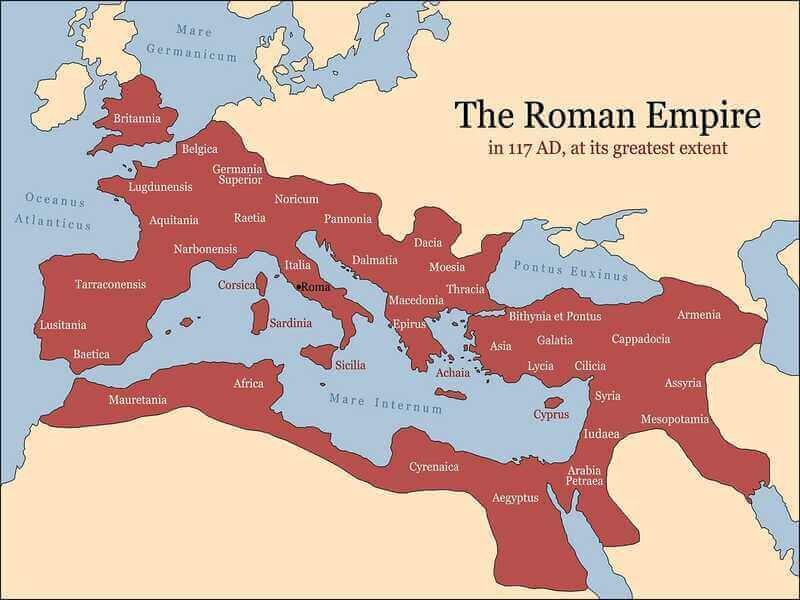
Originating from the city of Rome in present-day Italy, it expanded across Europe, North Africa, and the Middle East.
- Period: Founded in 753 BCE, with the Roman Republic from 509 BCE and the Empire in 27 BCE, lasting until the fall of the Western Roman Empire in 476 CE.
Roman Empire is known for its engineering marvels, legal systems, and political institutions, which have influenced countless governments and societies since.
- The Roman Empire is traditionally dated to 27 BCE, when Octavian (later known as Augustus) was granted the title “Augustus” by the Roman Senate, marking the end of the Roman Republic and the beginning of the Roman Empire.
- It reached its greatest extent under Emperor Trajan in 117 CE, spanning from Western Europe to the Near East and North Africa.
- In 285 CE, Emperor Diocletian divided the empire into the Western Roman Empire and the Eastern Roman Empire (also known as the Byzantine Empire), a division that became permanent by the end of the 4th century CE.
- The Western Roman Empire fell in 476 CE when the last Roman emperor, Romulus Augustulus, was deposed by the Germanic king Odoacer.
- The Eastern Roman Empire, with its capital at Constantinople (modern Istanbul, Turkey), endured until it fell to the Ottoman Turks in 1453.
- Initially polytheistic, the Empire officially adopted Christianity in the 4th century under Emperor Constantine the Great. This decision had a profound impact on the spread of Christianity in Europe and beyond.
Ancient Mesoamerica (Eg: The Maya Civilization)
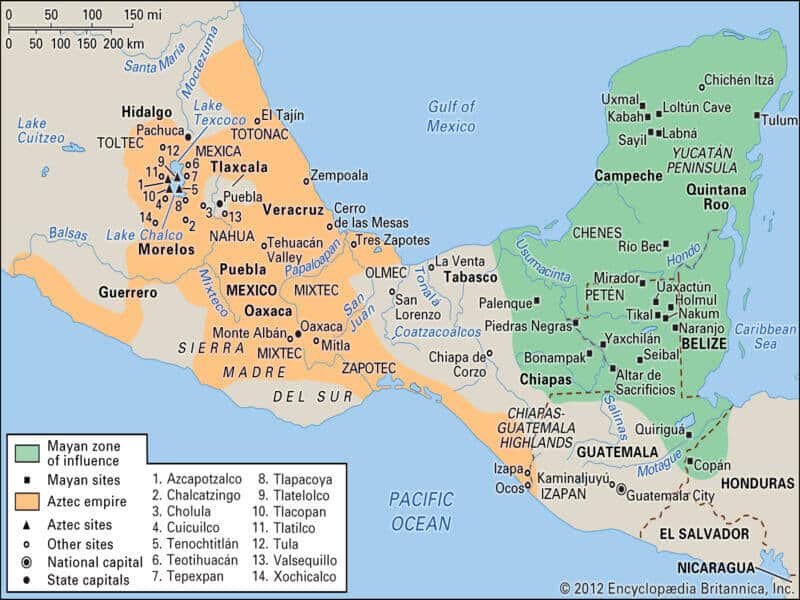
Parts of today’s Mexico and Central America were once home to several Indigenous cultures, beginning with the Olmec around 1200 BCE., followed by the Zapotec, Maya, Toltec, and, ultimately, the Aztecs.
- Pyramid-style temples, intricate pottery, stone monuments, turquoise jewelry, and other fine arts have been uncovered.
- Scholars believe the Zapotec developed Mesoamerica’s first written calendar and writing system, while the Mayans are noted for their advancements in mathematics, hieroglyphics, architecture, and astronomy.
- The nomadic Aztecs founded Tenochtitlan (today’s Mexico City) in 1325 on small islands in Lake Texcoco, and the city became a booming trade market.
- The Aztecs used a 365-solar calendar along with a 260-day ritual calendar, practiced human sacrifice and bloodletting, used a form of picture writing, and created works of art with terracotta, feathers, mosaics, and stone.
- The Hernán Cortéz-led 1519 Spanish invasion, aided by Mesoamerican foes of the Aztecs, brought the Aztec civilization to an end by 1521.
The Maya Civilization
The Mayans were spread across southeastern Mexico, Guatemala, Belize, and parts of Honduras and El Salvador.
- Period: Circa 2000 BCE to 1500 CE.
The Mayans were notable for their hieroglyphic script, the only known fully developed writing system in the pre-Columbian Americas, as well as for their art, architecture, mathematical, and astronomical systems.
- Preclassic Period (c. 2000 BCE to 250 CE): The Maya began as agricultural communities, with the formation of early settlements and the development of their distinctive culture.
- Classic Period (c. 250 CE to 900 CE): Marked by the peak of their culture, the Maya built great cities, made significant advancements in mathematics and astronomy, and developed a complex social and political order.
- Postclassic Period (c. 900 CE to 1500s CE): Characterized by the decline of the great lowland cities and the rise of power in the northern Yucatán Peninsula, until the arrival of the Spanish conquistadors.
- The Maya script is a sophisticated combination of phonetic symbols and logograms, enabling them to record historical events, astronomical observations, and rituals.
- They developed a vigesimal (base-20) numeral system, which included the concept of zero—an innovation not present in many contemporary cultures.
- Their understanding of astronomy was highly advanced, reflected in the accuracy of their calendars. The Maya calendar included the Tzolk’in (a 260-day ritual calendar), the Haab’ (a 365-day solar calendar), and the Long Count calendar, which could track vast expanses of time.
- The Maya built impressive cities like Tikal, Copán, Palenque, and Chichen Itza, featuring grand pyramids, palaces, plazas, and ball courts. Their architectural skills were also evident in their sophisticated water management systems, including reservoirs and aqueducts.
The Inca Empire
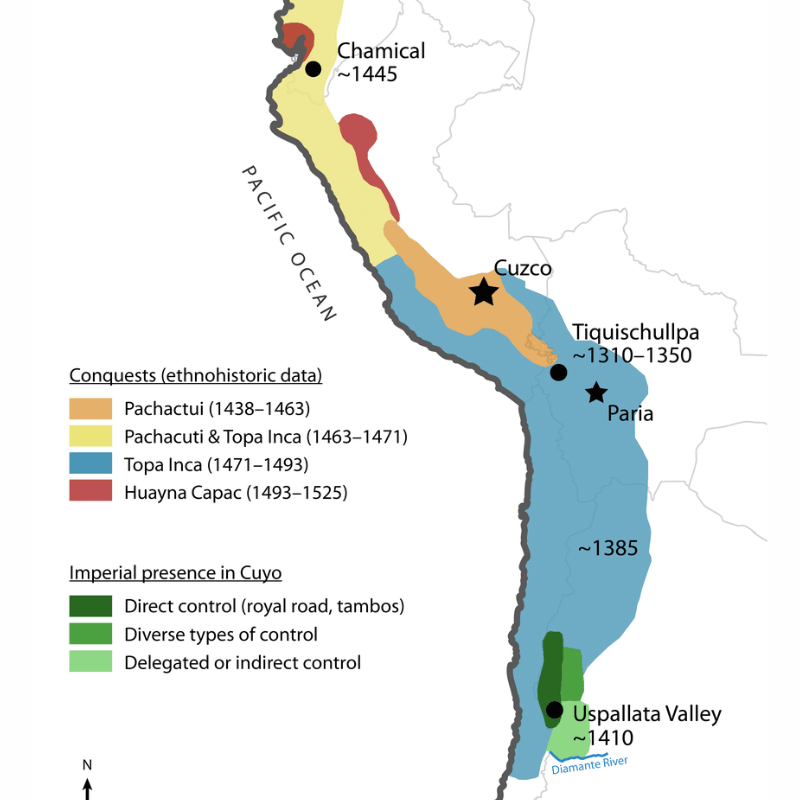
The Incas were centered in modern-day Peru, extending into Ecuador, Bolivia, Chile, and Argentina.
- Period: Early 13th century to 1532 CE.
The Inca Empire, also known as Tawantinsuyu, was the largest in pre-Columbian America.
- It emerged in the early 13th century from the highlands of Peru and, at its peak, extended across western South America, including large parts of modern Ecuador, Peru, Bolivia, Argentina, and Chile.
- The Inca civilization is renowned for its unique social structure, innovative agricultural techniques, and impressive architectural achievements, such as Machu Picchu.
- The empire was ruled by the Sapa Inca, considered both a political leader and a divine figure.
- The empire was divided into four provinces (suyus), each governed from a regional capital. Cusco, the capital, was at the center. The empire was highly organized, with a complex system of roads and communication networks.
- The Incas implemented a labor tax system called mit’a, requiring subjects to contribute labor to state and religious projects, including the construction of roads, temples, and agricultural terraces.
- The Incas used a unique system of knotted strings known as quipu for keeping records and communication. This system was vital for managing the empire’s economy and administration.
- The Inca Empire fell to Spanish conquistadors led by Francisco Pizarro in the 16th century.
- The conquest was facilitated by internal strife within the Inca Empire, including a civil war between the brothers Atahualpa and Huáscar, as well as diseases brought by Europeans.
Conclusion
These ancient civilizations, among others, have profoundly influenced human history, laying the groundwork for societal development and cross-cultural exchanges that have shaped the modern world.
Their achievements in governance, science, art, and philosophy continue to be studied and admired to this day.
For more world history notes click here.
-Article by Swathi Satish






Leave a Reply